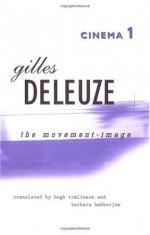|
This section contains 511 words (approx. 2 pages at 400 words per page) |

|
The Affection-Image Face and Close-Up Summary and Analysis
Two poles of the face are power and quality that presents affection-image as a type of image, like the close-up, which is also a part of all images. Eisenstein identifies the face with the close-up. The author compares the face of a clock to illustrate dimensions of a face which he claims has the two poles of a "reflecting and reflected unity." Hands of a clock move in micro-movements, called "intensive series" on the face of a clock and its immobile face is often presented in close-up. A painted portrait has two poles comprised of the face, as outline, and its features like lips or a look. The face presents questions of what the person is thinking about or what the person is feeling. For example, Griffith's martyred girl in "Broken Blossoms" shows...
(read more from the The Affection-Image Face and Close-Up Summary)
|
This section contains 511 words (approx. 2 pages at 400 words per page) |

|




